Updated: December 18, 2025
By Santorini Dave
My Favorite Amalfi Coast Hotels
• Positano: Il San Pietro
• Amalfi: Santa Caterina
• Ravello: Palazzo Avino
• Praiano: Casa Angelina
• Maiori: Botanico San Lazzaro
• Vietri sul Mare: Relais Paradiso
• Capri: Caesar Augustus
• Sorrento: Excelsior Vittoria
• Naples: Britannique
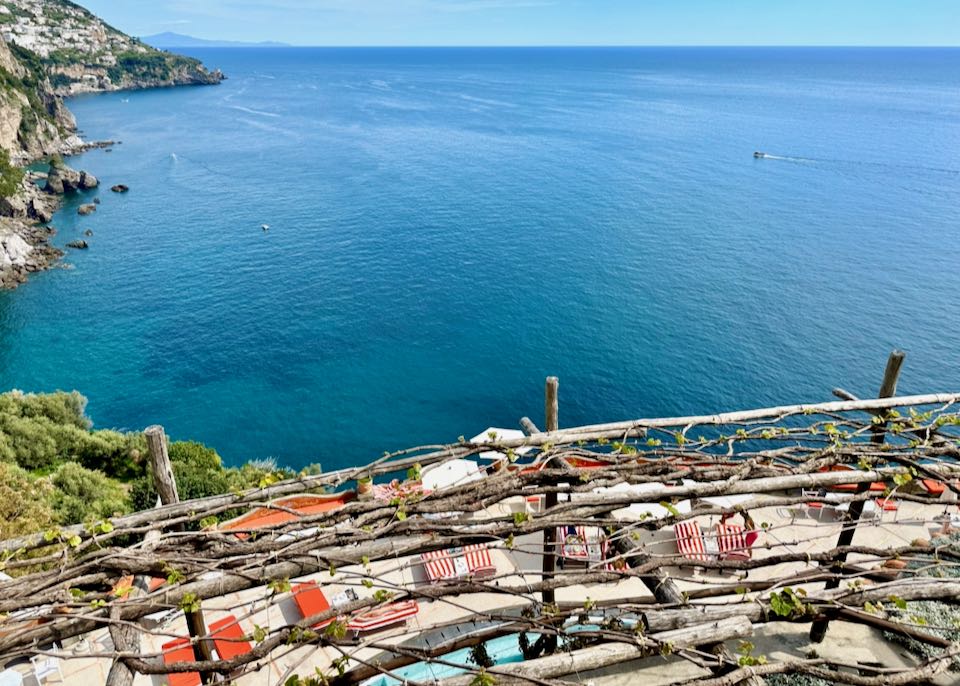
The fantastic perch of Il San Pietro di Positano Hotel on the Amalfi Coast.
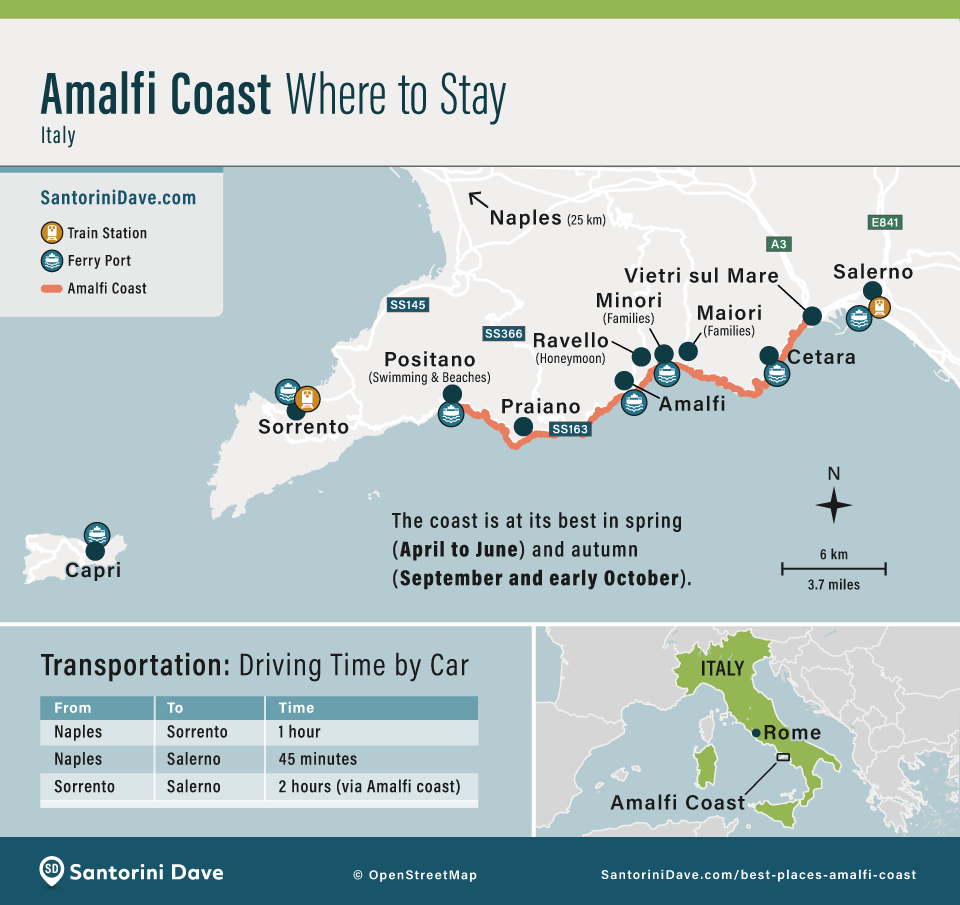
Staying on the Amalfi Coast
The Amalfi Coast is a UNESCO World Heritage stretch of coastline in Campania, famous for its vertical cliffs, lemon groves, and turquoise water. While beautiful, it can be logistically challenging. The “coast” is actually a collection of distinct towns connected by a winding, often traffic-clogged road and a network of ferries.
Choosing the right base is critical. Positano is the glamour capital but requires climbing steep stairs. Amalfi Town is the transport hub, making it the easiest base for sightseeing. Ravello offers the best views but sits high in the mountains with no direct beach access. Sorrento (technically just north of the coast) is the most practical choice for day-tripping to Pompeii and Naples. Check out our Amalfi Coast maps to get a feel for the layout.
Amalfi Coast Towns
- Positano (The Glamour Hub)
The most famous and photogenic town, known for its pastel houses cascading down to the sea. It’s the center of luxury hotels, fashion boutiques, and nightlife.
• Pros: Stunning views, great beaches (Spiaggia Grande and Fornillo), and romantic atmosphere.
• Cons: It’s steep. Expect to climb hundreds of stairs daily. The most expensive and crowded town.- Amalfi Town (The Transport Hub)
Historically a maritime superpower, Amalfi is now the logistical heart of the coast. Its flat historic center is dominated by the spectacular 9th-century Cathedral (Duomo di Amalfi).
• Pros: It’s the main bus and ferry terminal, making it the easiest base for exploring other towns without a car. Walkable and flatter than Positano.
• Cons: The main piazza gets incredibly crowded with day-trippers in midday.- Ravello (The Quiet Balcony)
Perched 365 meters above the sea, Ravello is famous for its music festival and the gardens of Villa Rufolo and Villa Cimbrone.
• Pros: Peaceful, sophisticated, and cooler than the coast. Maybe the best views in Italy.
• Cons: No direct beach access. Need to take a bus or taxi down to the water.- Praiano (The Sunset Village)
Located between Positano and Amalfi, Praiano is a spread-out fishing village that feels more authentic and lived-in.
• Pros: It gets the most sun (and best sunsets) on the coast. Quieter and cheaper than its neighbors.
• Cons: Spread out along the highway, meaning you might walk long distances along the road to reach restaurants.- Maiori & Minori (Best for Families)
Sister towns connected by the scenic “Path of the Lemons” walk. Maiori features the longest sandy beach on the coast.
• Pros: They are the only towns with flat waterfronts and boardwalks, making them ideal for strollers and travelers with mobility issues. Prices are lower here.
• Cons: Maiori has modern apartment blocks (rebuilt after a flood) rather than historic charm.- Vietri sul Mare & Cetara (The Authentic Ends)
Vietri is famous for its ceramics and has the coast’s only train station (easy access to Naples/Salerno). Cetara is a working fishing village famous for its world-class anchovies and tuna. Both offer a glimpse of “real” Italy away from the tourist hordes.- Sorrento (The Strategic Base)
While technically on the Sorrentine Peninsula (not the Amalfi Coast), Sorrento makes a good first stop.
• Why stay here? It has the best transport links: the Circumvesuviana train to Pompeii and Naples, and fast ferries to Capri and Positano. It has a flat, walkable center with excellent dining and shopping.- Salerno (The City Alternative)
A working city at the southern end of the coast. It has a direct high-speed train connection to Rome (2 hours). Much cheaper than the tourist towns, with a great “local” vibe, a historic castle, and a large promenade.- Capri (The Luxury Island)
A 20-minute ferry ride from Sorrento. Capri is legendary for the Blue Grotto, high-end shopping, and dramatic scenery. It’s magical at night once the day-trippers leave, but accommodation is expensive.Hopping by ferry between Amalfi Coast towns is a delight.
Getting Around the Amalfi Coast – My Tips
- 1. Take the Ferry Whenever Possible
This is the golden rule of Amalfi Coast travel. The coastal road (SS163) is legendary for its beauty, but also for its gridlock. Ferries are faster, cooler, and offer better views.
• The Routes: Ferries connect all the main towns (Salerno, Vietri, Cetara, Maiori, Minori, Amalfi, Positano) and Sorrento/Capri.
• The Season: Regular service runs from April through October. In winter, service is limited or non-existent.
• The Companies: Travelmar operates the smaller boats that stop at every village along the coast. NLG and Caremar run the larger, faster boats to Capri and Sorrento.
• Tip: Buy tickets online in advance for July and August. In shoulder season, buying on the dock 20 minutes before departure is fine.- 2. Understand the SITA Bus Reality
The blue SITA buses are the only public transport option for towns without ports (like Ravello) or for winter travel. They are cheap (€2–€5) but come with a catch.
• The Crowds: In summer, buses are often standing-room only. If the bus is full, the driver will not stop, leaving you stranded on the side of the road for an hour.
• The Strategy: Always board at a terminal stop (Amalfi Town or Sorrento) to guarantee a seat. If you try to board mid-route (e.g., in Praiano), you might not get on.
• Tickets: You cannot buy tickets on the bus. You must buy them at a “Tabacchi” (cigarette shop) or bar before you board. Validate the ticket in the machine when you step on.- 3. Do Not Rent a Car in Summer
I strongly advise against driving yourself between May and September.
• The Traffic: The road is narrow and winding. You will spend hours stuck behind large tour buses that cannot pass each other on corners.
• The Parking: Parking is non-existent or expensive (often €8–€10 per hour in Positano). Many hotels do not have parking.
• The ZTLs: Most towns have “Traffic Limited Zones” (ZTL) where unauthorized driving results in heavy fines captured by cameras.
• Scooters are for Experts Only: Renting a Vespa seems like a romantic Italian dream, but the Amalfi Coast is one of the most dangerous places in Europe to learn how to ride. The roads are slick, steep, and filled with aggressive drivers. Only rent a scooter if you have significant motorcycle experience at home.
• Use Private Drivers for “Luggage Days”: While expensive, hiring a private driver for your arrival and departure days is worth it. Dragging heavy suitcases onto a ferry, then up cobblestone stairs, or squeezing onto a crowded bus is miserable. A private transfer from Naples Airport to Positano costs roughly €130–€160, but it is stress-free and door-to-door.
• Exception: A car can be useful for exploring the southern coast (Paestum/Cilento) or if you are visiting in deep winter (November–March).Best Places to Stay on the Amalfi Coast
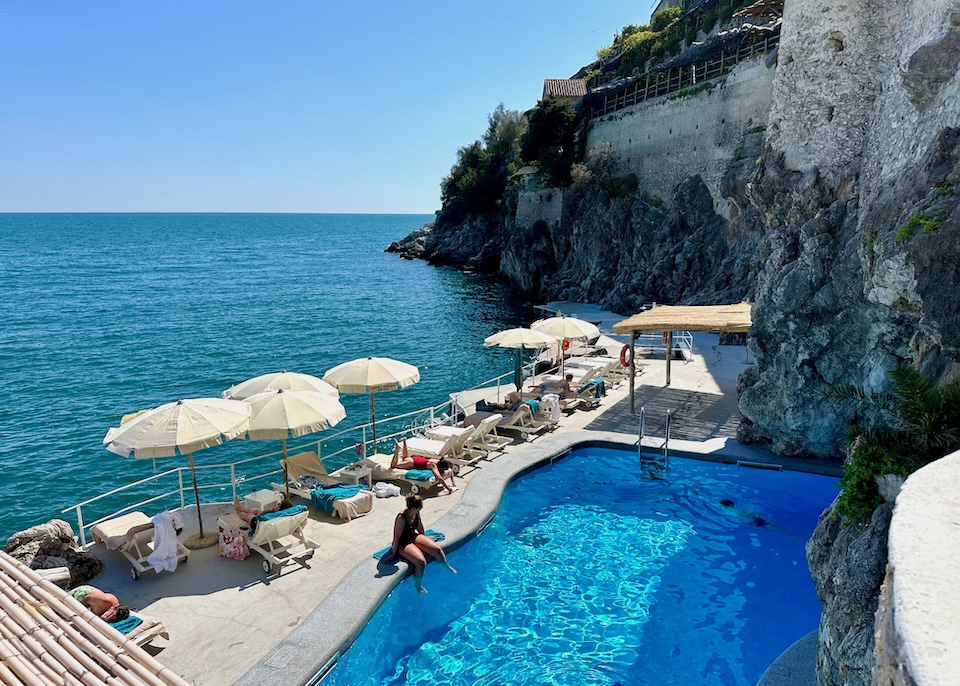
The heated saltwater pool on the sea at Hotel Santa Caterina in Amalfi.
- Best Luxury Hotels on Amalfi Coast
Il San Pietro (Positano) • Santa Caterina (Amalfi) • Palazzo Avino (Ravello)- Best Hotels for Families on Amalfi Coast
Eden Roc (Positano) • Luna Convento (Amalfi) • La Valle delle Najadi (Vietri sul Mare)- Best Hotels for Couples on Amalfi Coast
Palazzo Avino (Ravello) • Il San Pietro (Positano) • Casa Angelina (Praiano)
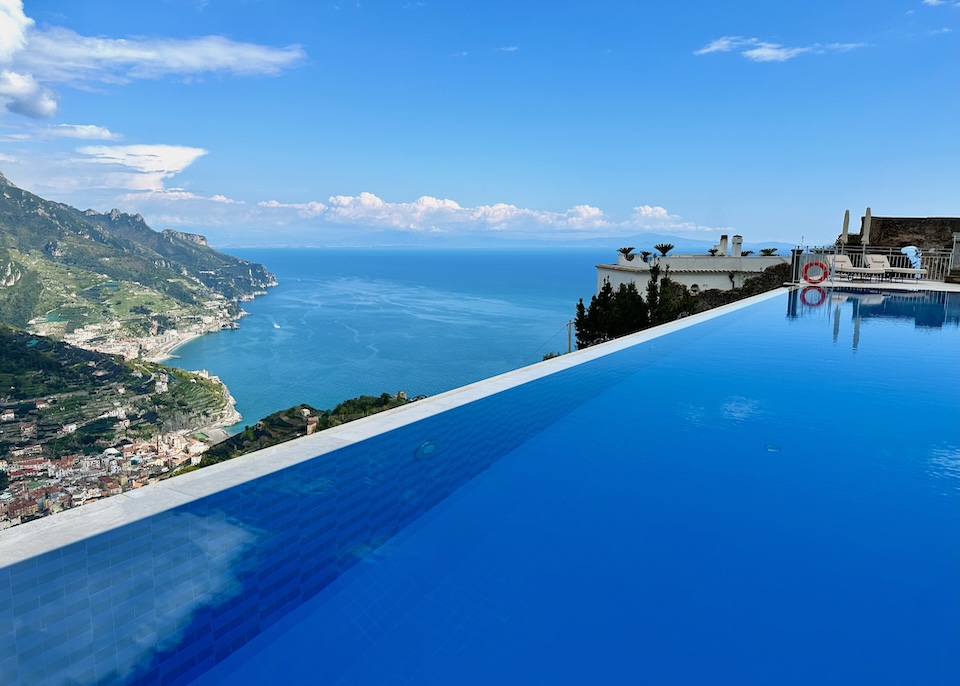
Views from the infinity pool at Caruso high in Ravello face over the sea and the towns of Minori (foreground) and Maiori (background).
- Best Boutique Hotels on Amalfi Coast
Villa Magia (Positano) • Casa Angelina (Praiano) • Palazzo Murat (Positano)- Best Cheap/Midrange Hotels on Amalfi Coast
La Tavolozza Residence (Positano) • La Valle delle Najadi (Vietri sul Mare) • Parsifal (Ravello)- Best Beach Resorts on Amalfi Coast
Most “private beaches” on the coast are actually concrete platforms. These hotels have natural sand:
Cetus (Cetara) • Marincanto (Positano) • Borgo Santandrea (Amalfi)
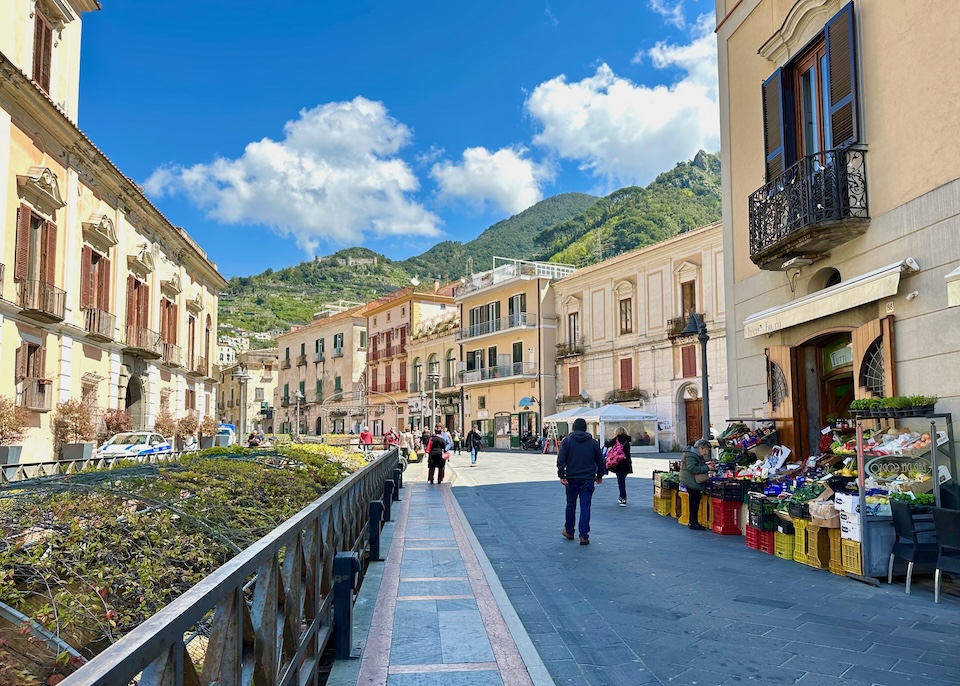
Corso Reginna is the main shopping street of Maiori, one of the largest towns on the Amalfi Coast.
Best Places to Stay for …
- Where to Stay on Amalfi Coast for First Timers: Positano
Often considered the jewel of the Amalfi Coast, Positano is our recommended spot for first-time visitors. It’s a charming and idyllic town with colorful houses cascading down the cliffside. Its steep, narrow streets are lined with boutiques, cafes, and galleries, making a delightful area for exploration. The town’s main beach, Spiaggia Grande, is perfect for sunbathing and swimming. Positano is also well-connected by ferry to other coastal towns and the island of Capri, making it an excellent base for day trips.- Where to Stay on Amalfi Coast for Families: Maiori and Minori
Less obviously quaint than many Amalfi Coast towns, Maiori is a good bet for families with small kids. It has a long sandy beach and a good choice of restaurants and hotels – accommodation here tends to be slightly cheaper than elsewhere on the coast. Parents with strollers will appreciate the flat streets which make getting around pretty stress-free. A short hop away, the smaller town of Minori is another kid-friendly resort popular with Italian families.
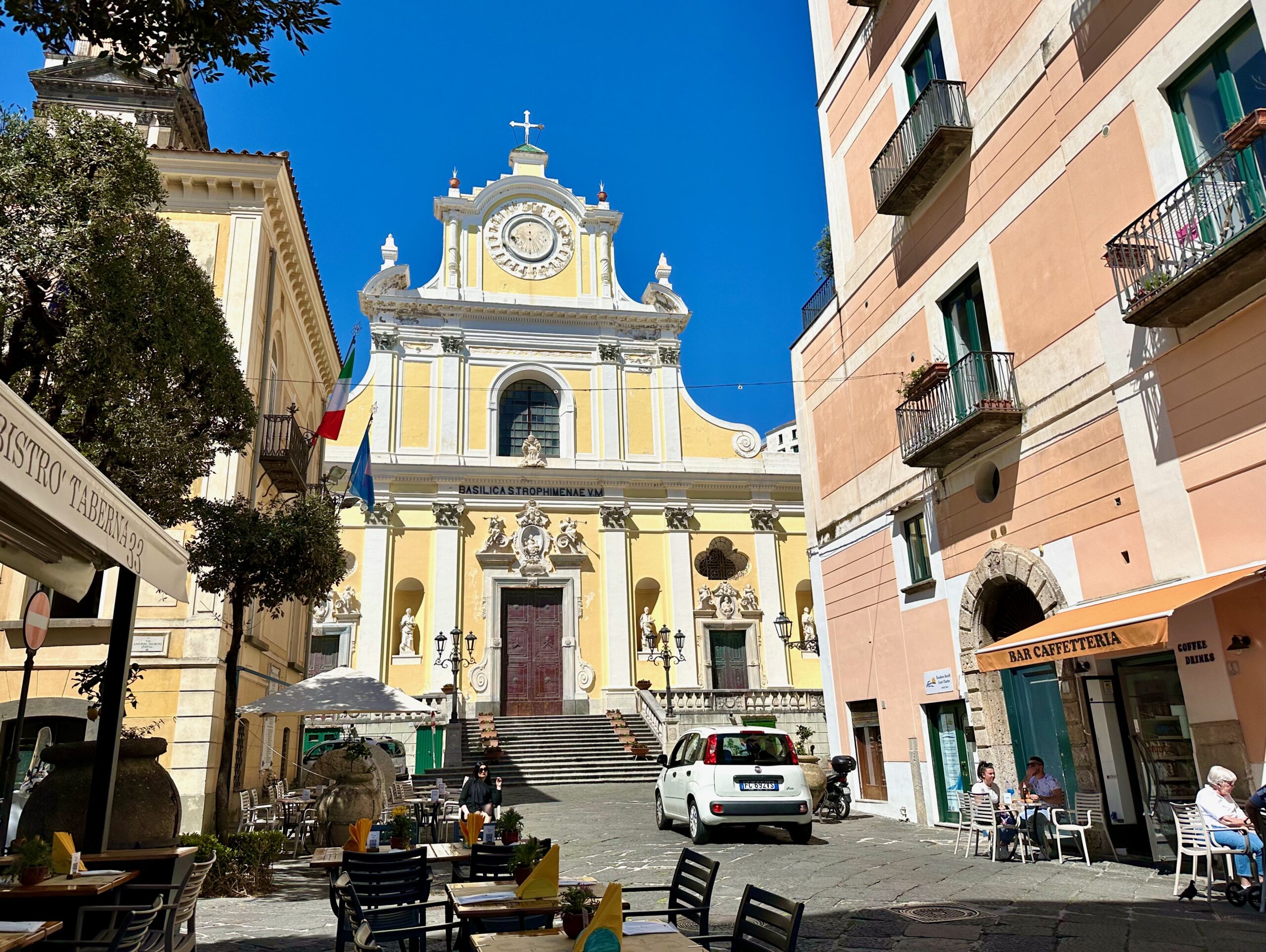
Despite its small size, Minori has a few important landmarks like the neoclassical Basilica of Saint Trofimena, which houses the relics of the town’s patron saint.
- Where to Stay on Amalfi Coast for Swimming and Beaches: Positano
Positano has two beaches of its own, and with good bus connections and a wealth of boat hire outfits, it’s well set up for beach-combing along the coast. In town, Spiaggia Grande is the focus of Positano’s hectic summer scene, while Spiaggia Fornillo provides a quieter alternative. Nearby, Spiaggia Arienzo is a charming beach reached by a flight of almost 300 steps. Positano is many people’s first choice on the coast, so expect to pay top whack if you stay here.- Where to Stay on Amalfi Coast for a Honeymoon: Ravello
Few places can rival Ravello for couples and honeymooners. A charming hilltop village set amidst lemon terraces and olive groves, it oozes elegance with its historic villas and unforgettable views – for one of the best views, stay at Villa Cimbrone. Touristy by day, it comes into its own in the evening when the day-trippers have gone home and romance hangs in the balmy air. Accommodation-wise, Ravello has several fabulous hotels, including the Caruso whose magical infinity pool is made for romantic selfies.- Where to Stay on Amalfi Coast to Live Like a Local: Vietri Sul Mare
Vietri sul Mare’s daily rhythm remains largely undisturbed by the influx of tourism in other Amalfi Coast towns. Visitors here will find deep-rooted artisan traditions and a less tourist-centric atmosphere (though there are still plenty of great hotels and easy transportation). The town is known for its vibrant ceramic industry, a craft that has flourished here for centuries. Hand-painted maiolica pottery adorns the streets flush with numerous ceramic workshops and stores. Vietri’s local cuisine, primarily focused on fresh seafood and traditional recipes, is best experienced in small, family-run trattorias where recipes are handed down through generations. The town’s less commercial and more relaxed atmosphere, combined with its scenic beauty, from quaint streets to picturesque beaches, offers a genuine taste of coastal living in Southern Italy.
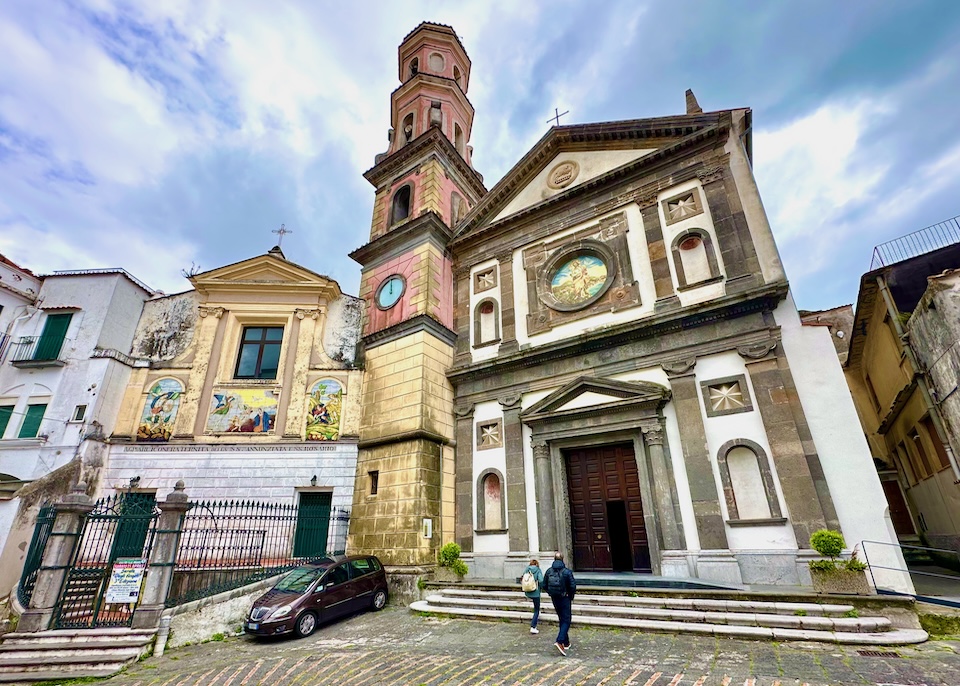
Vietri sul Mare’s distinctive Church of St. John the Baptist is decorated with the hand-painted maiolica pottery the town has been making since Roman times.
- Where to Stay on Amalfi Coast to Avoid Crowds: Cetara and Praiano
Understated Praiano is home to serene beaches with clear waters and thinner crowds than its neighbors, offering a more peaceful seaside experience. The absence of a ferry service helps preserve Praiano’s local atmosphere and keep crowds at bay, while regular bus connections to nearby towns ensure accessibility. Praiano’s rich heritage is visible in its centuries-old churches, local artisan workshops, and friendly, family-run restaurants. Many of central Praiano’s main streets are linked by terraced roads, footpaths, and stairways featuring colorful ceramic artworks depicting traditional life, mythology, and more. Picturesque yet relatively obscure Cetara makes for an idyllic retreat largely untouched by the heavy foot traffic of its neighbors, despite being on the main ferry route connecting the coast’s hotspots. Travelers will find winding lanes, unspoiled beaches, and laid-back lifestyle. Visitors can soak up the unassuming beauty of its historic architecture and maritime traditions without the interference of large tourist groups. Locally, Cetara is renowned for its seafood, particularly its anchovy and tuna products. The town’s small, family-run restaurants offer an array of exquisite dishes and authentic flavors in an intimate, peaceful environment.
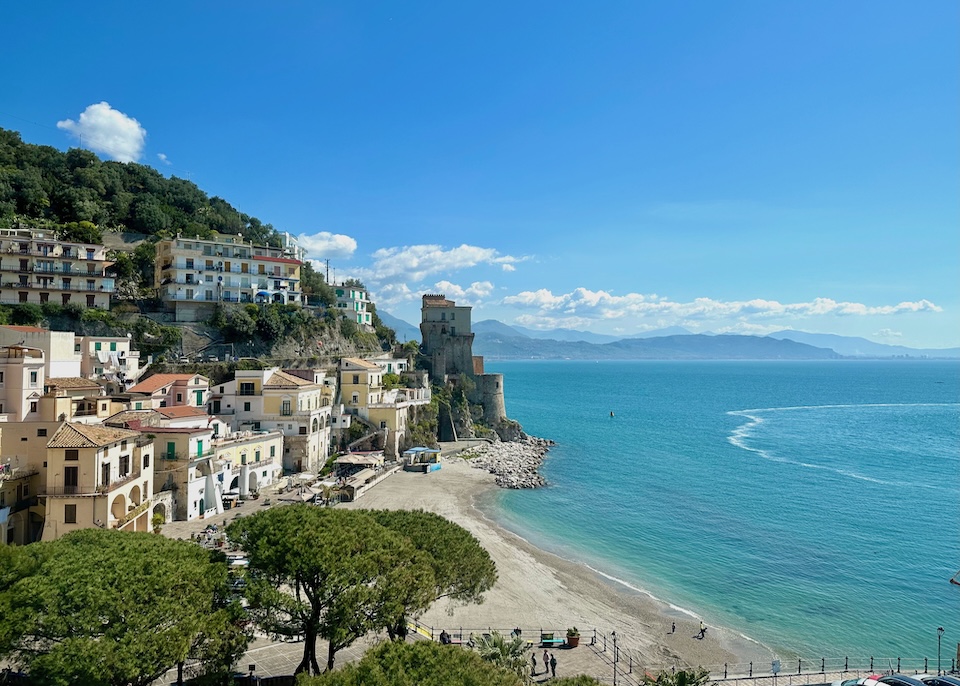
Low-key Cetara with its medieval Viceregal Tower is the quietest of the beach towns along the Amalfi Coast.
- Where to Stay on Amalfi Coast without a Car: Amalfi
Without a vehicle, Amalfi makes an excellent base (especially for first time visitors). It’s centrally located, and as the coast’s main transport hub, has excellent bus and boat connections, making day-tripping a breeze. There are a few sights to see in town if you want to stay put, including a beach, medieval cathedral, and historic paper museum. All the main sights are in the compact center which can easily be explored on foot. There’s also a good choice of accommodations for all budgets and plenty of cafes, bars, and restaurants. Both the Hotel Fontana and Albergo Sant’Andrea Hotel have fantastic central locations close to buses and ferries in the heart of Amalfi.- Where to fly into for the Amalfi Coast?
The nearest airport is Naples International Airport though it’s also easy to get to the coast from Rome’s Leonardo da Vinci (Fiumicino) Airport. From Naples, take the Campania Express (mid-March to mid-October) or slower Circumvesuviana train to Sorrento, from where buses run to Positano and Amalfi. Alternatively, get a faster train to Salerno and pick up a bus from there. Boats run year-round from Naples to Sorrento and in summer from Sorrento and Salerno to towns along the coast. Another option is a private transfer from Naples.
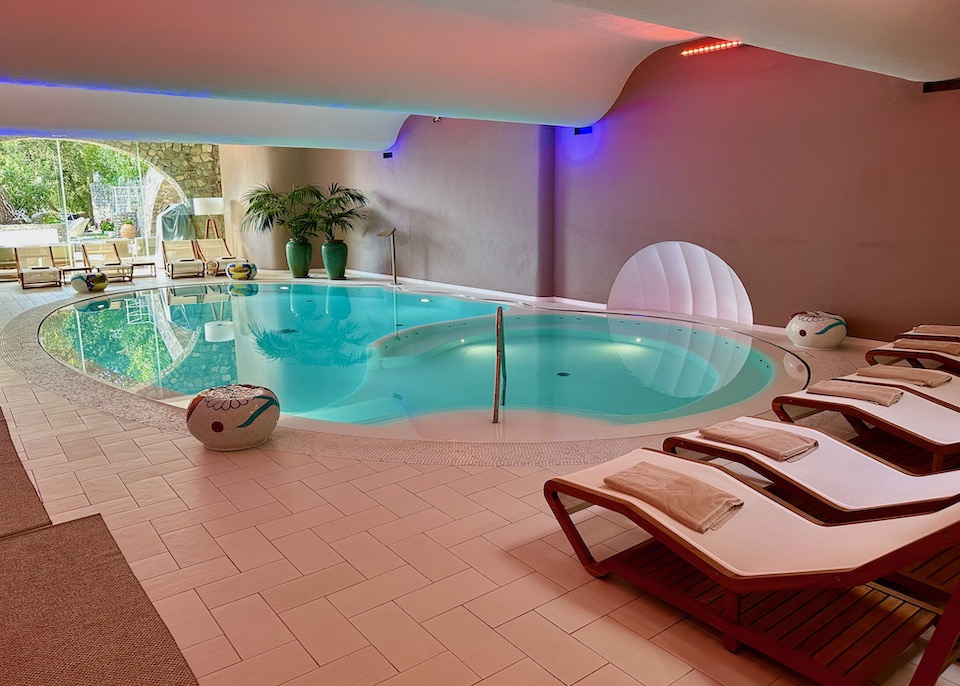
The indoor spa pool at Piccolo Sant’Andrea in Praiano.
- When is the best time to visit the Amalfi Coast?
The coast is at its best in spring (April to June) and autumn (September and early October). Spring is a colorful time with pleasant temperatures and blooming flowers; autumn brings sunny weather and thinner crowds. As a rule, it’s generally warm enough to swim from June through to October. Try to avoid August when everywhere is packed, prices skyrocket, and temperatures are torrid. Note that many hotels, restaurants, and bars close over winter, typically from November to Easter.- How do you get around the Amalfi Coast?
Forget driving. The narrow coastal road (the SS163) is not an easy or fun drive and has many blind curves and heavy summer traffic. Parking is also a nightmare. Better to use public transport. Buses are a good, cheap option with regular services to all the main towns and villages. Be warned though, travel sickness is a possibility, particularly for kids. To avoid the roads, seasonal ferries run along the coast serving Amalfi, Positano, and other ports of call between mid-May and October.- How long is the Amalfi Coast?
The Amalfi Coast forms the southern shore of the Sorrentine Peninsula, a mountainous spur of land about 30km south of Naples. The main stretch runs for 40km from Positano in the west to Vietri sul Mare in the east. Distances are not huge but traveling along the tortuous coastal road is time-consuming. As a rough guide, allow just over an hour for the bus ride from Sorrento to Positano, and an hour and forty-five minutes from Sorrento to Amalfi. Approaching from Salerno, plan on an hour and fifteen minutes to Amalfi.The 12 Best Towns on the Amalfi Coast
1. Positano
Positano is the most visually stunning of the coast’s main towns. A riot of multi-colored houses, it cascades down a steep hillside to a small beach overlooked by a domed church – to get the best views, try to arrive by sea. There are a handful of sights in town like the Santa Maria Assunta Church, which houses a Byzantine-era Black Madonna icon, and the MAR (Roman Archaeological Museum) located in the church’s crypt. But time here is usually spent hanging out on the beach and browsing boutiques filled with ceramics, wispy linen fashions, and handmade leather sandals. There’s plenty of accommodation, but hotels are in high demand and rates are universally high. Be advised that Positano is known as the vertical village – if you stay here, expect to climb lots of hills and stairs.
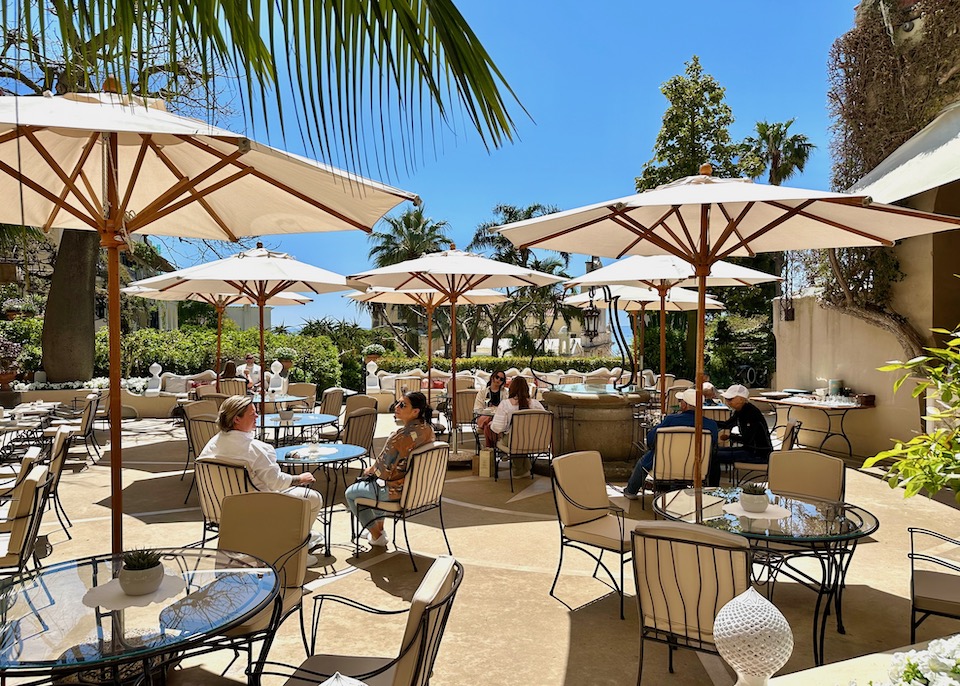
The courtyard bar of Palazzo Murat in the heart of the town.
- Best Luxury/Boutique Hotels: Il San Pietro di Positano • Villa Magia • Palazzo Murat • Hotel Marincanto • Eden Roc
- Best Cheap/Midrange Hotels: La Tavolozza Residence • Albergo California
2. Amalfi
Bustling Amalfi impresses with its seafront location and historical attractions. These include a museum in a centuries-old paper mill and a striking cathedral, a vestige of Amalfi’s past as a medieval maritime republic. Action is centered on Piazza del Duomo, an attractive square flanked by cafes, restaurants, and bars. Nearby, you can laze on the town’s small beach or hop on a boat to the Grotta dello Smeraldo, a sea cave famous for its eerie emerald light. Amalfi is the main transportation hub along the coast. All bus and ferry routes to and from Amalfi Coast towns begin and end here (so, to get to Cetara from Positano, for example, you’ll have to change buses or boats in Amalfi). This is the best town to stay in for exploring the region without a car.
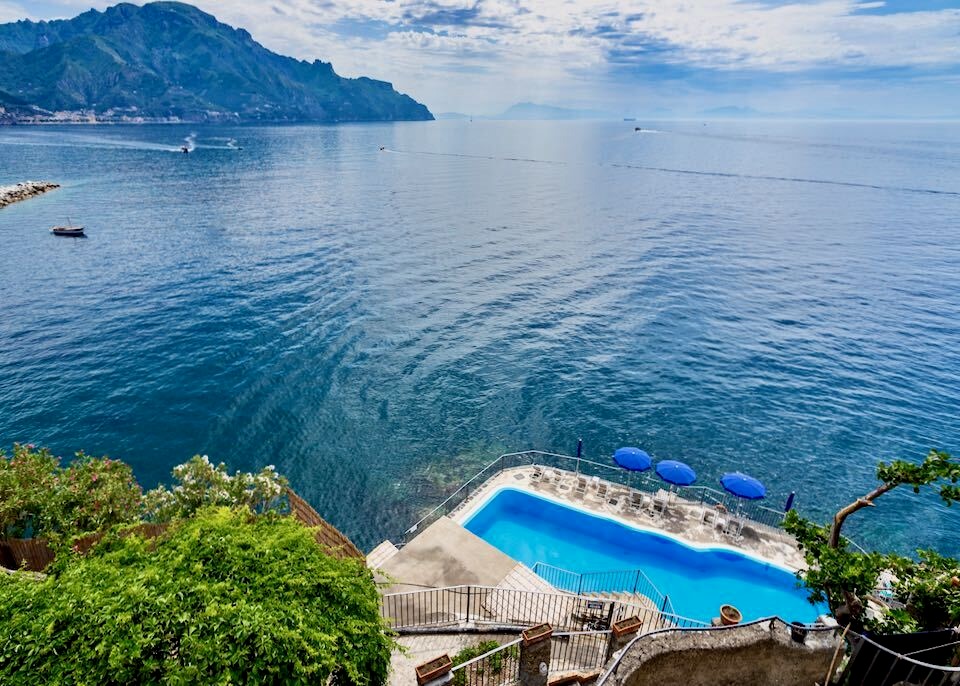
The seafront pool of Luna Convento, once a Franciscan monastery.
- Best Luxury/Boutique Hotels: Santa Caterina • Borgo Santandrea • Luna Convento
- Best Midrange Hotels: Residenza Luce • Albergo Sant’Andrea
3. Ravello
Overlooking the coast from its high hilltop perch, Ravello is an enchanting village famous for its breathtaking views and elegant gardens. Villa Rufolo and Villa Cimbrone are the two main sights, both boasting lush, landscaped gardens. The medieval cathedral is also popular, known for its mosaic art and distinctive pulpit with twisting columns and marble lions. The strikingly modern Oscar Niemeyer Auditorium hosts concerts and exhibitions. Culture-vultures will also enjoy Ravello’s popular summer festival which sees events staged across the village from July to September. There’s no direct access to the sea, but if you’re after a quiet, romantic stay, there are some magnificent top-end hotels here.
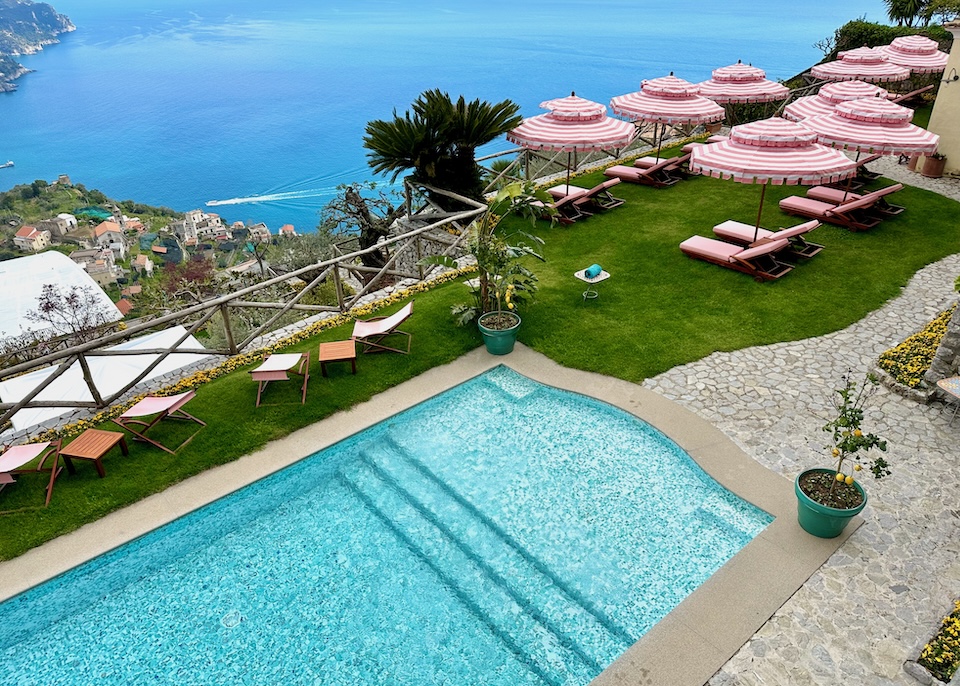
The garden terrace with a heated pool and sweeping views at Palazzo Avino.
- Best Luxury/Boutique Hotels: Palazzo Avino • Caruso • Villa Cimbrone • Villa Piedimonte
- Best Cheap/Midrange Hotels: Hotel Parisfal • Villa Casale Residence
4. Praiano
Praiano is a sprawling village midway between Positano and Amalfi. Generally overlooked by visitors, it’s becoming increasingly trendy with travelers who are drawn by its authentic, low-key vibe. Its main landmarks are two art-filled, medieval churches (San Gennaro and San Luca Evangelista). Praiano is well-placed for the beach – a steep staircase leads to the popular Spiaggia della Gavitella – and its sunset views are among the best on the coast. Ideal for hiking, Praiano is one of two possible starting points for the Path of the Gods, the Amalfi Coast’s best-known hiking trail. NaturArte is a lesser known collection of walking trails in the town that act as an open-air art gallery featuring installations and sculptures by local and international artists.
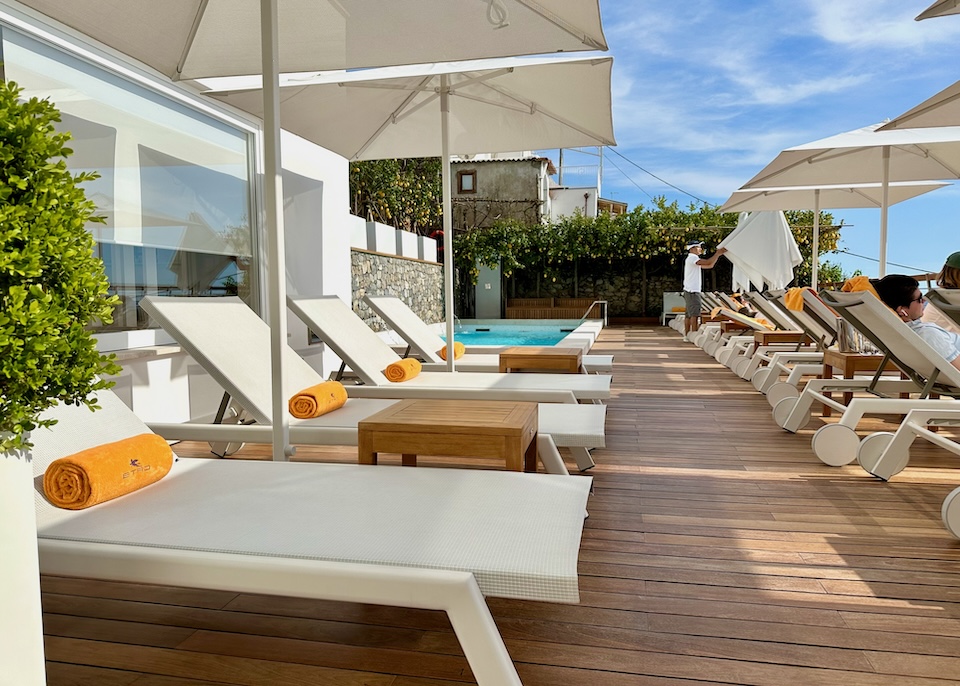
The poolside terrace with a lemon-shaded pergola at Casa Angelina.
- Best Luxury/Boutique Hotels: Casa Angelina • Grand Hotel Tritone • Piccolo Sant’Andrea • Hotel Onda Verde • Villa Corallium
5. Maiori
With its broad sandy beach (the longest on the coast) and bustling seafront, Maiori is the most obvious resort-like town here. It’s a favorite with vacationing Italians. While it lacks the picture-postcard charms of its better-known neighbors, it is laid-back and lively. It’s also one of the coast’s less expensive towns. Many of the buildings here are “newer” post-war apartments, though there are plenty of architectural gems to see, including Palazzo Mezzacapo (known for its frescoes and gardens), the hilltop Castle of San Nicola de Thoro-Plano (a 9th-century fortress with nine towers and panoramic views), and Santa Maria a Mare Church (take the Path of the Lemons to get a close up view the dome’s intricate, maiolica construction). Continue on the hiking trail to reach neighboring Minori town.
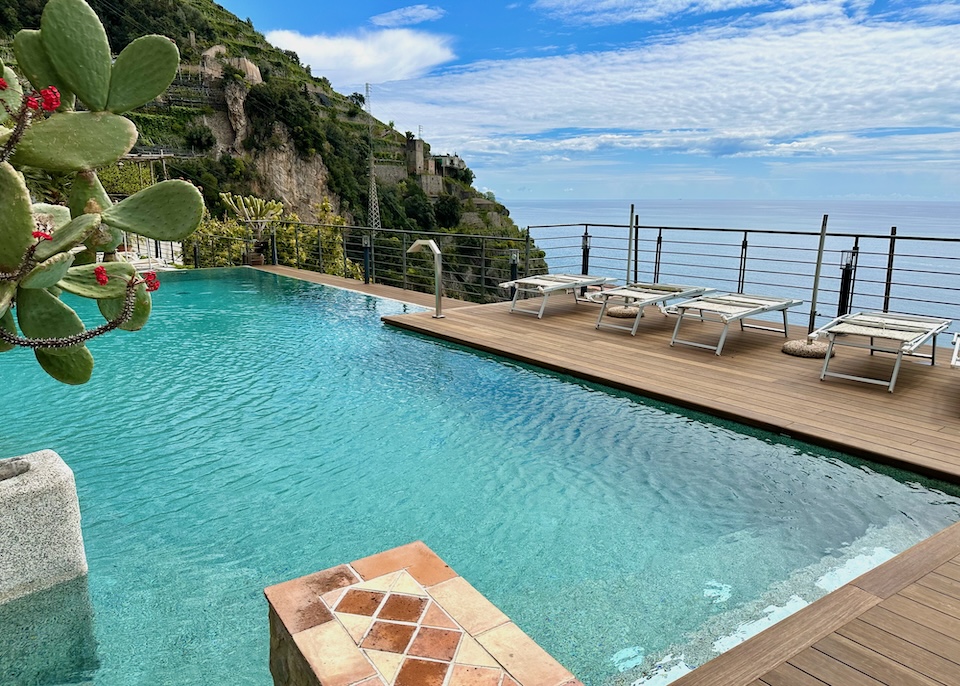
The sea-view pool set in the botanical gardens of Botanico San Lazzaro.
- Best Luxury/Boutique Hotel: Botanico San Lazzaro
- Best Cheap/Midrange Hotel: Residence Panoramic
6. Minori
Minori, a short way to the west of Maiori and connected by the hiking trail, The Path of the Lemons, offers a similar atmosphere as its sister town but on a smaller scale: calm, clear sea, a sandy beach with sunbed/umbrella sets for rent, and a handful of casual, family-friendly restaurants. Minori is home to one of the coast’s most important ancient sites, the little Villa Romana, the vacation home of a Roman elite dating to the 1st century BC. You’ll also find the neoclassical Basilica of Santa Trofimena with a 19th-century bell tower and Baroque crypt, where the saint’s bones are kept.

Outside the boutique hotel Minori Palace.
- Best Luxury/Boutique Hotel: Minori Palace
- Best Cheap/Midrange Hotel: Palazzo Vingius
7. Cetara
Cetara is a small village on the less crowded eastern part of the coast. It’s a pretty spot with a small beach, typical domed church, and imposing watchtower. The town is characterized by narrow, winding streets and traditional houses that cluster around the central focal point, the Church of San Pietro Apostolo. But its main claim to fame is its seafood, considered the best on the coast. Tuna is a local specialty, and the village is home to an important tuna fishing fleet. Anchovies are another revered local delicacy. For a taste, try spaghetti alla colatura, made with Cetara’s signature anchovy sauce.

There’s only one luxury hotel in Cetara, the lovely Cetus with a private beach, wellness center, and restaurant.
- Best Luxury/Boutique Hotel: Cetus
- Best Cheap/Midrange Hotel: Cetara Albergo Diffuso
8. Vietri sul Mare
Cliffside Vietri sul Mare marks the easternmost point of the Amalfi Coast; it’s walking distance from Salerno. Vietri is the capital of Campania’s ceramics industry and has been producing glazed maiolica pottery since Roman times. Its colorful streets and even the church are lined with ceramic murals, and shops burst with tiles, tableware, and objets d’art, many hand-painted in shades of sunny lemon yellow. Vietri depends less on tourism than other towns on the coast, giving it a more authentic, Italian, small-town feel than you’ll find in the other beach towns. However, there’s still plenty to see and do here as a traveler. Ceramics classes are on offer at a few of the studios here, and there’s also a ceramics museum inside the garden-ringed Villa Guariglia. Near the villa, there’s an organic winery offering tours, tastings, cooking classes, and picnics with panoramic sea views. Of course, the wide, sandy beach is the main draw here with tranquil waters, sunbed sets for rent, and several good-quality restaurants just steps from the water’s edge. Vietri sul Mare is the only town on the Amalfi Coast with a train station (in addition to a ferry port and bus stops), making it an excellent spot for exploring the wider region without a car.
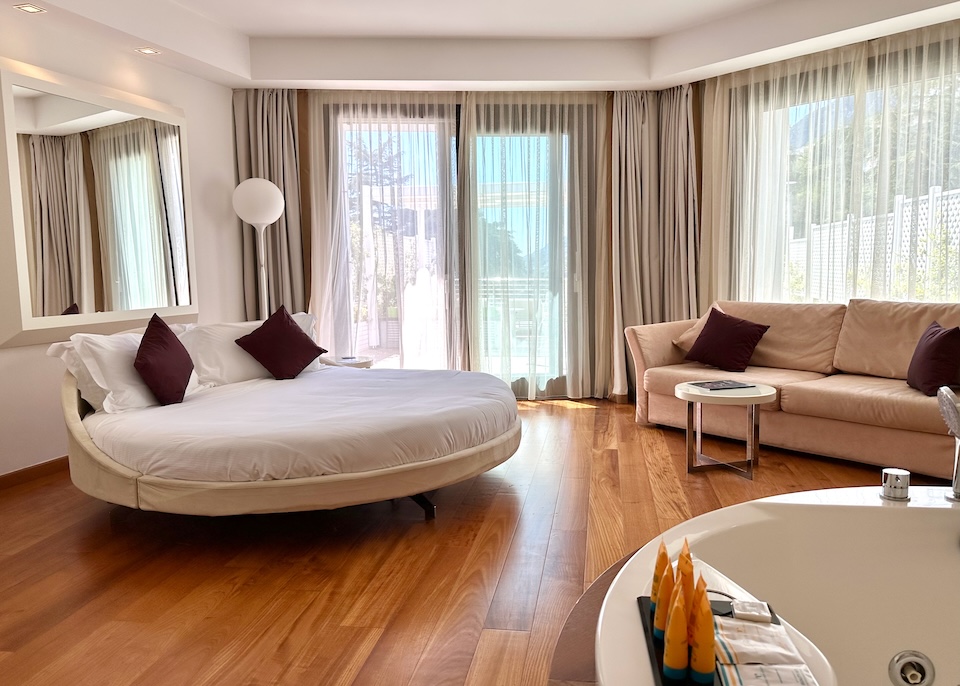
The Paradiso Suite at Relais Paradiso also has an outdoor, jetted plunge pool on its terrace.
- Best Luxury/Boutique Hotels: Relais Paradiso • Hotel Raito • Palazzo Suriano
- Best Cheap/Midrange Hotel: La Valle delle Najadi
9. Sorrento
Though not technically on the Amalfi Coast, Sorrento makes a good base for exploring the coast and surrounding areas. It’s a handsome, laid-back town with an appealing historic center. Attractions include the ancient Cloister of San Francesco, famed for its Arabesque arches, and the Correale di Terranova Museum, housing an extensive collection of Neapolitan art and artifacts. The town’s vibrant Piazza Tasso is a hub of activity, surrounded by shops, cafes, and the historic Vallone dei Mulini, a deep gorge with ancient mills. Sorrento offers a mix of small, picturesque beaches and bathing platforms set along the rocky coastline with stunning views of the bay and Mount Vesuvius. Good transportation links give plenty of scope for day trips: buses and summer ferries run to Positano and Amalfi; hydrofoils serve Capri; the Circumvesuviana train rattles up to Pompeii, Herculaneum, and Naples.
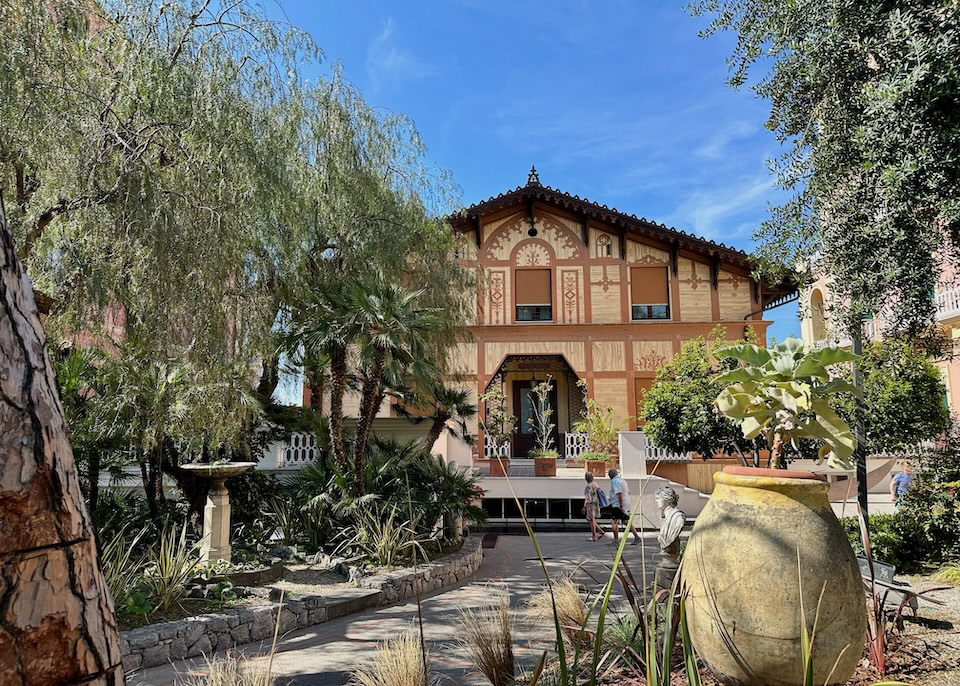
A surprising Swiss-style chalet is one of the three buildings making up the Grand Excelsior Vittoria in the historic center of Sorrento.
- Best Luxury/Boutique Hotels: Grand Hotel Excelsior Vittoria • Bellevue Syrene • Grand Cocumella • Maison La Minervetta • Grand La Favorita
- Best Cheap/Midrange Hotels: Cristina • Hotel Del Mare
10. Salerno
The coast’s principal eastern gateway, Salerno lies a few kilometers to the east of the Amalfi Coast. A working port city, it’s not an obvious place to stay, but if you’re looking for someplace well-connected, vibrant, and relatively tourist-free, it’s worth considering. In town, check out the palm-fringed, seafront promenade. Its historic center is an atmospheric tangle of shady cobbled lanes, neighborhood trattorias, bars, and boutiques. The city’s Norman cathedral, considered one of Italy’s most beautiful medieval churches, is a must-see. The city’s medieval sector is also home to a thousand-year-old aqueduct. Head uphill to find Minerva’s Garden, the oldest botanical garden in Europe, known for its medicinal plants. Continue higher still to reach impressive Arechi Castle, perched on a hilltop offering panoramic views of the city and the coastline.
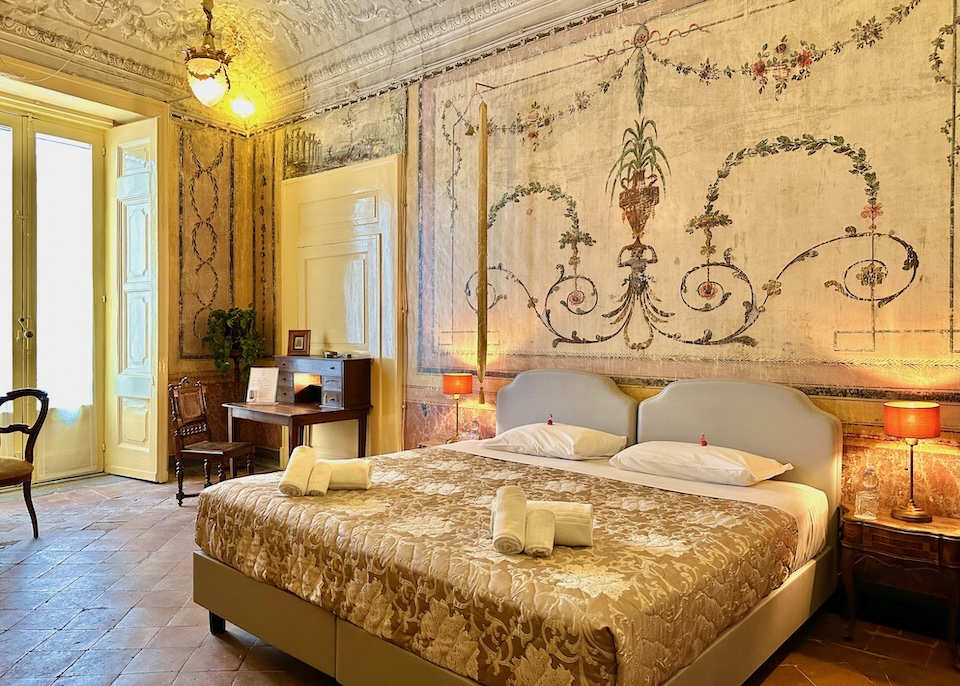
Original frescoes adorn the suites at Casa Santangelo in the city’s historic center.
- Best Luxury/Boutique Hotels: Casa Santangelo
- Best Cheap/Midrange Hotels: Montestella • Bruman • B&B Les Lumières
11. Capri
The quintessential Mediterranean idyll, the island of Capri boasts ancient ruins, white cube villages, and a rugged, rocky coastline. Most people visit on a day trip – ferries sail from Naples and points along the coast – but it has a good supply of high-standard accommodation for longer stays. Action is focused on Capri Town and its chic open-air main-square, Piazza Umberto I (usually called the Piazzetta), while hill-top Anacapri offers an equally luxurious yet laid back visit. Worth visiting are the Certosa di San Giacomo, a 14th-century charterhouse turned museum, and adjacent Giardini di Augusto, terraced gardens with breathtaking views of the Faraglioni rock formations. Natural highlights include the Grotta Azzurra (Blue Grotto) sea cave, where sunlight passing through an underwater cavity creates a blue reflection. Beaches tend to be small and pebbly here, many set in secluded coves with crystal clear water.

The heated, split-level infinity pool at Caesar Augustus in Anacapri.
- Best Luxury/Boutique Hotels: Caesar Augustus • JK Place • Villa Brunella • La Minerva • Casa Mariantonia
- Best Cheap/Midrange Hotels: Capri Wine Hotel • Villa Eva
12. Naples
Naples is a great base (and transport hub) for exploring the highlights of the region: Pompeii, Herculaneum, Mt. Vesuvius, Campi Flegrei, and the Amalfi Coast. There are also regular boats to Capri, Ischia, Sicily, and Sardinia. But Naples is the third largest city in Italy and packed with culture, charm, history, and plenty of must-see landmarks, so travelers shouldn’t be too quick to head for the port or train station. There are seven castles in the city. The entirety of Naples’ Historic Center is a UNESCO World Heritage site, home to numerous medieval and Renaissance churches stuffed with impressive artwork, like the Sansevero Chapel and its exquisite Veiled Christ sculpture. The National Archaeological Museum, one of the most important archaeological museums in the world, showcases a vast collection of Roman artifacts from Pompeii and Herculaneum. For something more hands-on, visitors can take one of the city’s many pizza-making workshops or join a food tour to delve deeper into the city’s rich culinary traditions.
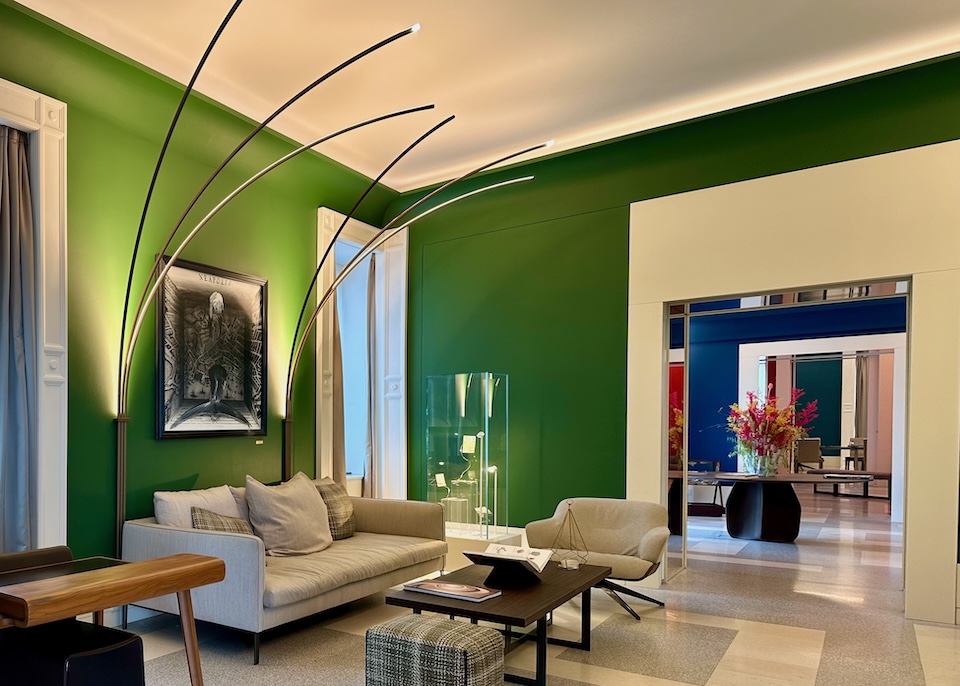
Contemporary style in a historic building at The Britannique in the romantic Chiaia neighborhood.
- Best Luxury Hotels: The Britannique • Romeo • Santa Chiara • Grand Hotel Vesuvio • Artemisia Domus
- Best Cheap/Midrange Hotels: SuperOtium • Piazza Bellini
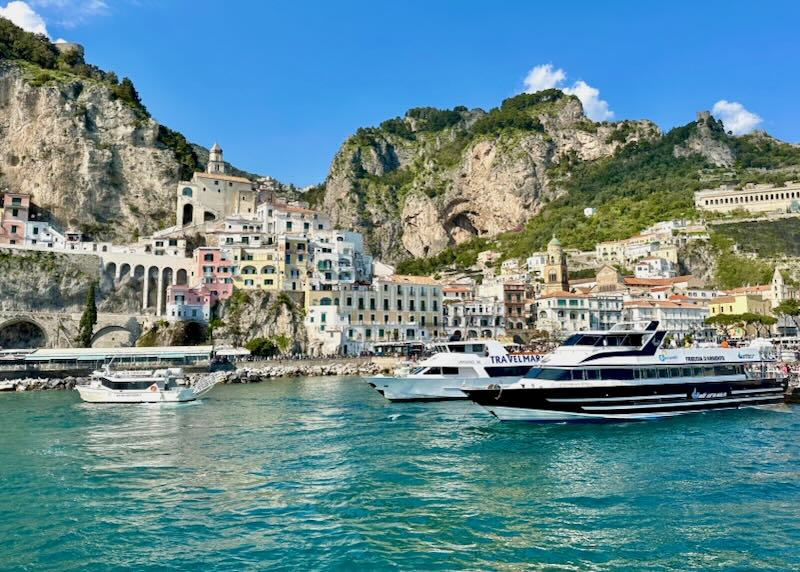
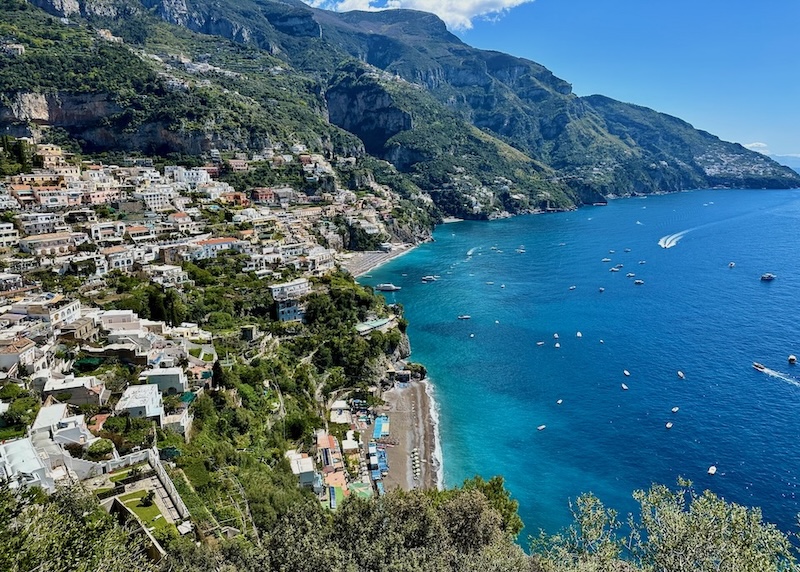

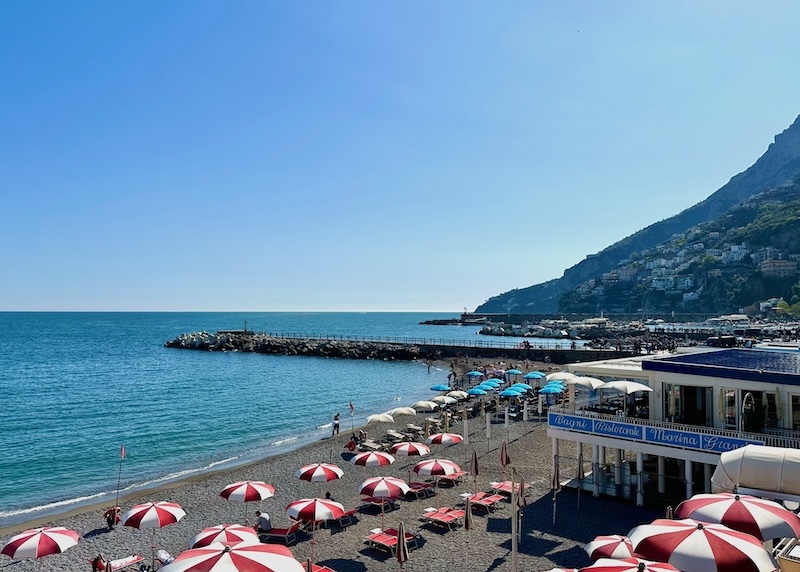

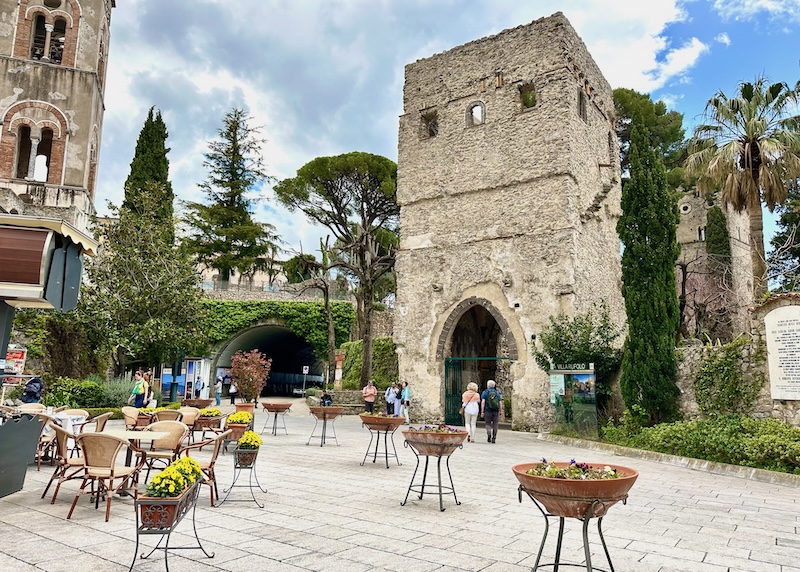

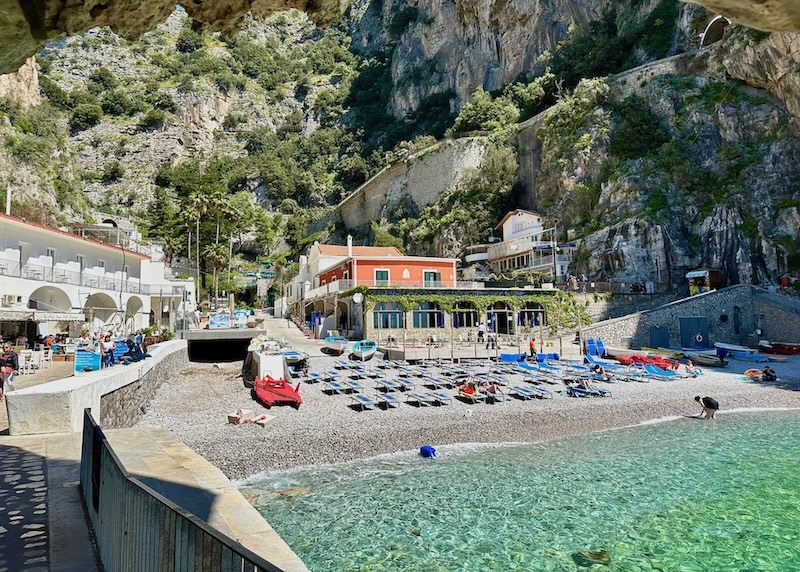

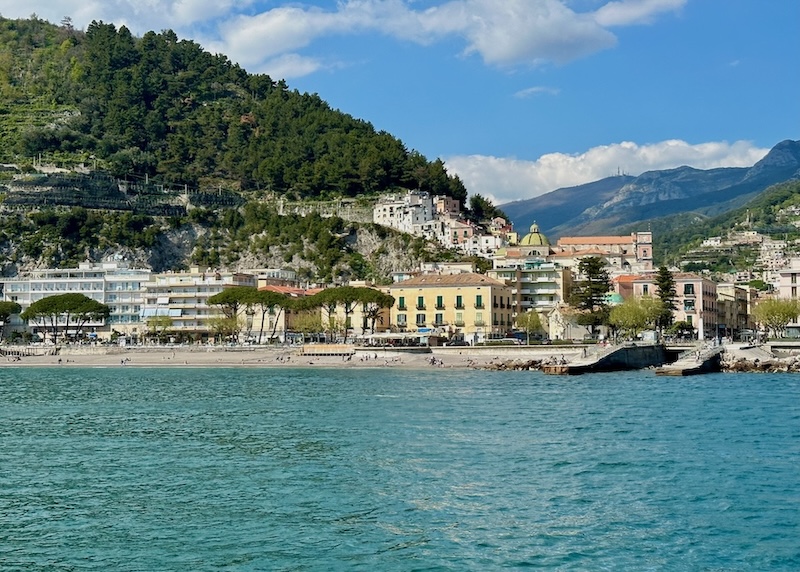

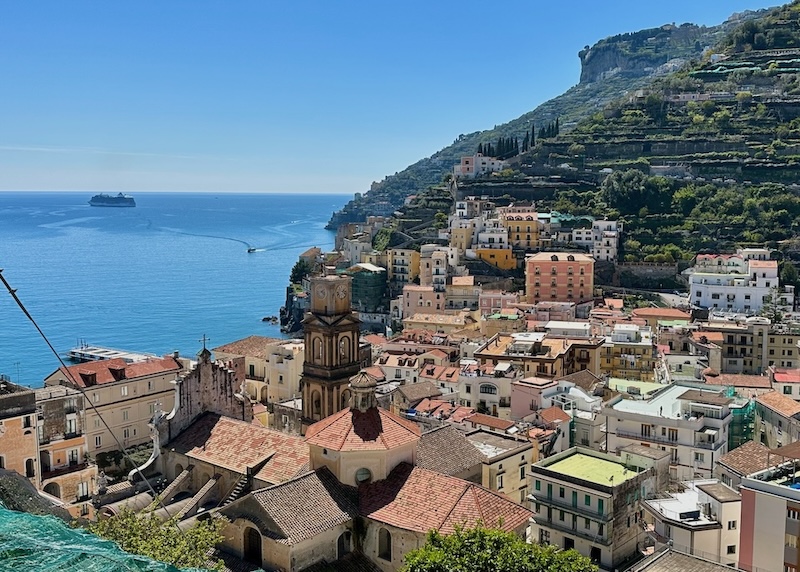

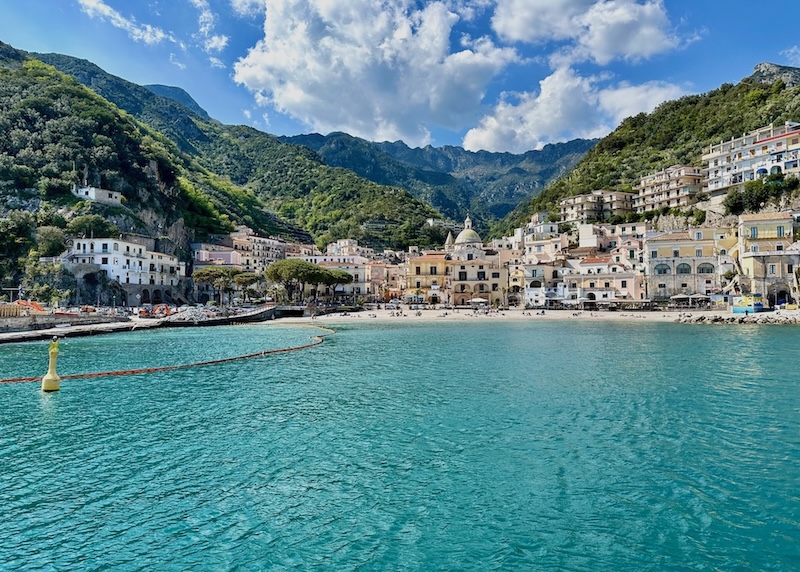

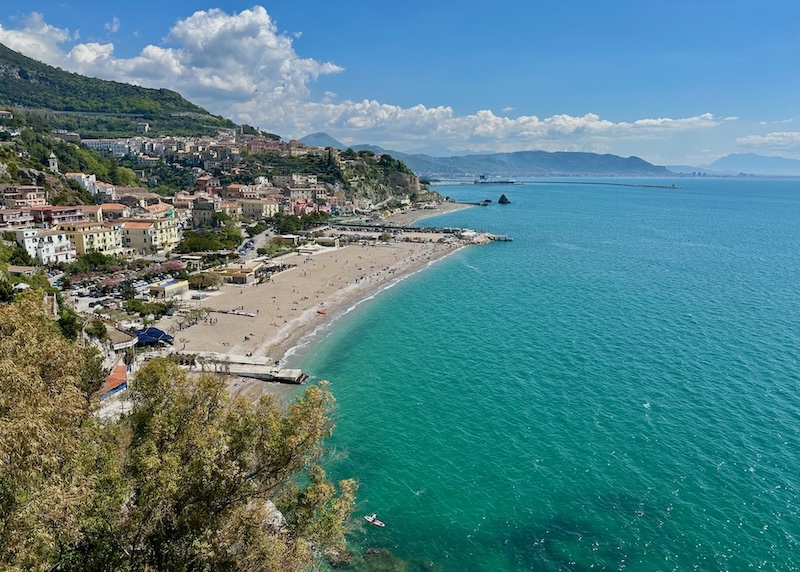

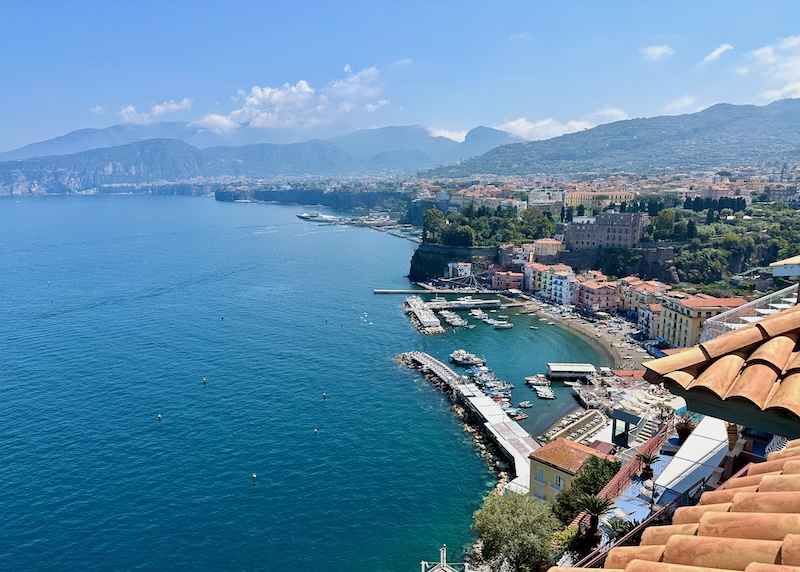

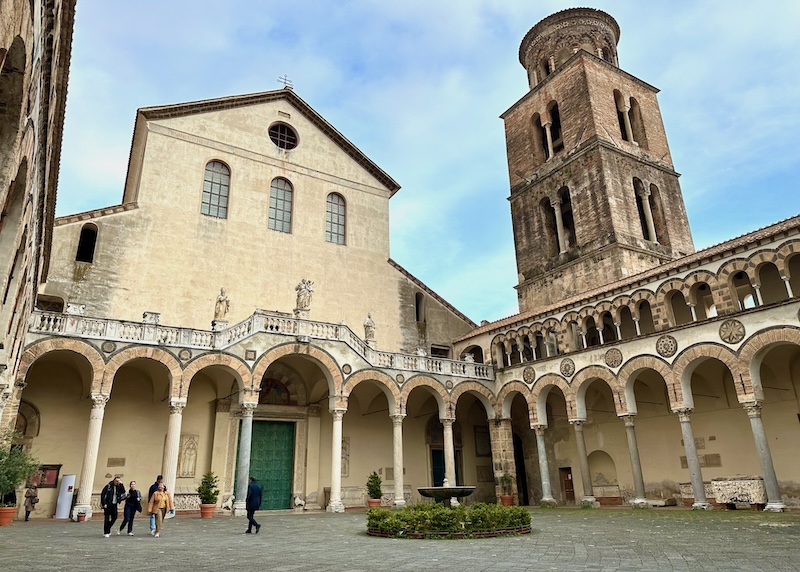

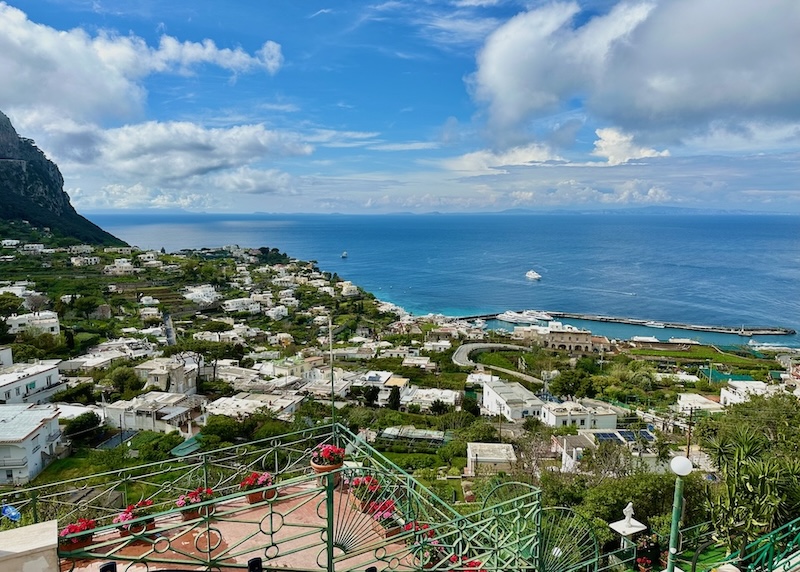



About Santorini Dave